Text
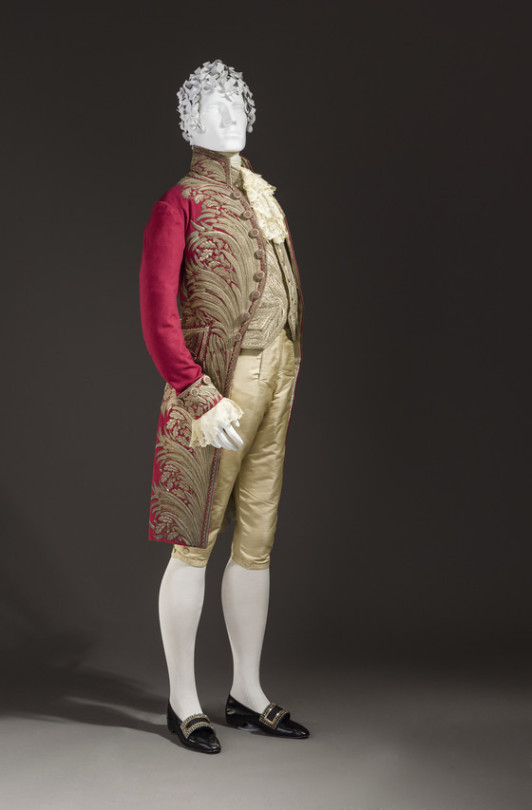
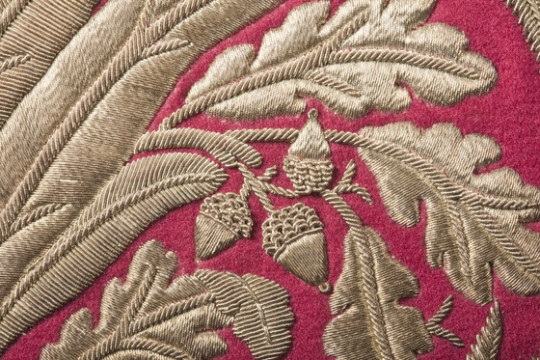

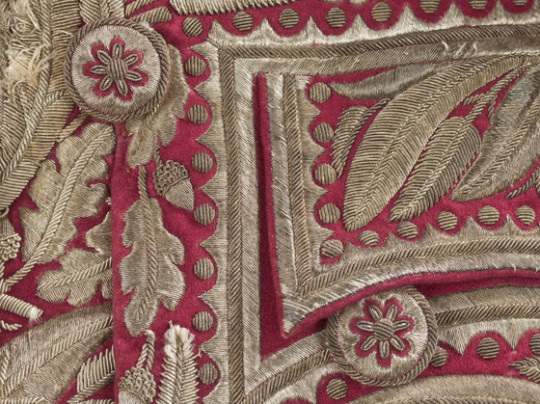
Italian court coat and waistcoat, ca 1800
From the Los Angeles County Museum of Art
67 notes
·
View notes
Text

FINALLY SEVIKAAAA!!! By Romain Mazevet
21 notes
·
View notes
Text
To myself: “It’s ok to make bad art it’s ok to make bad art it’s ok to make bad art it’s ok to make bad art”
*the art is bad*
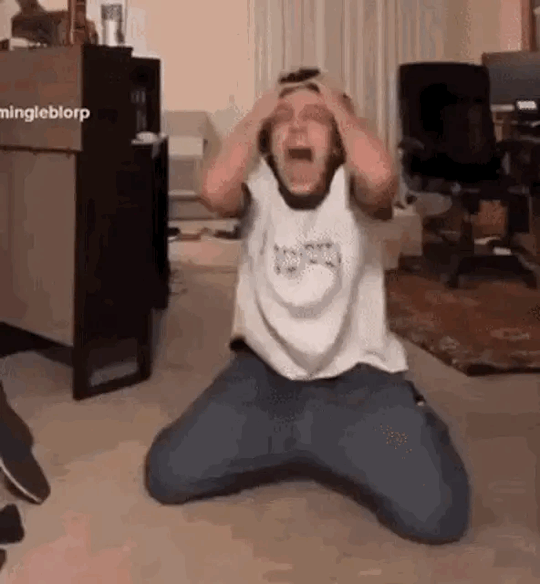
27K notes
·
View notes
Text


Nonso Ojukwu at Casablanca SS 24
172 notes
·
View notes
Text

Gift that I gave to @annadeef for their bday a couple months ago, their dnd character Sly. God I love that cvnt, the most amazingest tiefling fr I love her so much y'all.
#dnd#tiefling#my art#sly#on an unrelated note i feel like im in a pretty good place with my portraits rn i habby
54 notes
·
View notes
Text

Lesson 1: "White Man Painted Black"?
Okay, I recognize that this is a strong foot to step off on! But! If you learn nothing else from this series, if you decide for whatever reason to forsake me: this is the ONE perspective I'd like you to take away!
You may have heard this quote before, when Black fans deride a character design as 'a white man with the brown bucket tool'. On its face, it means exactly what was said. But specifically, what it means is that we recognize that whomever designed the character drew the way they normally draw for a 'default' character in their mind- default usually meaning White/Eurocentric features- and they added a shade of brown within the line art to make that character now 'Black'.
Now if you're feeling defensive, wait just a moment! This discomfort is not inherently a bad thing!
I'm going to use both a 'real world' example first, to show you what your Black fans and peers are seeing, and perhaps you will also understand our discomfort!
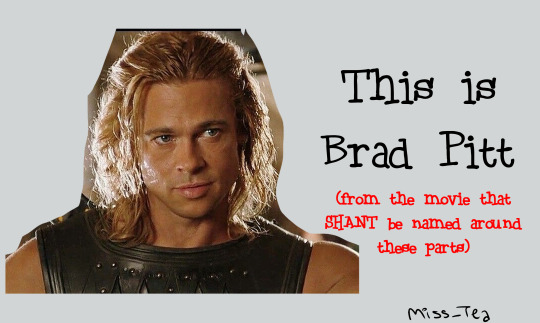
(if anyone was curious, my folder for this lesson is titled 'brad' lmao and you'll see why)
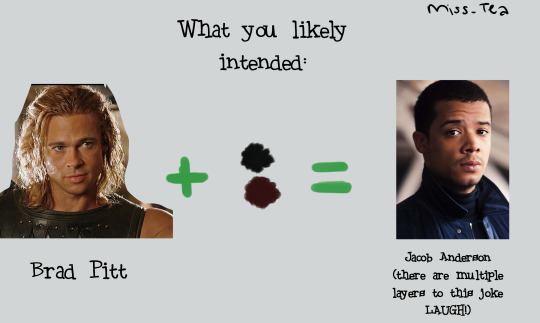
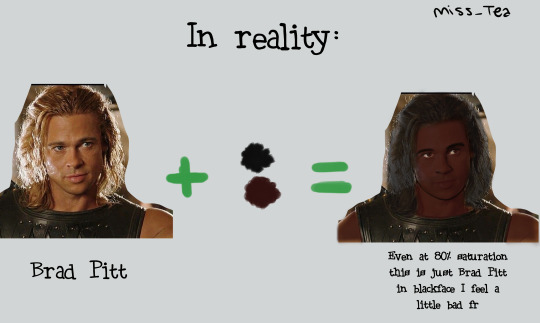
(I'll have y'all know that I actually worked very hard to make Blackface Brad look mildly presentable lmao I'm sorry, I'm wheezing, I can hardly breathe looking at him 🤣)
You see how, despite knowing where this was going, and using one of the darkest shades of brown in my Skin Tones arsenal, you still know that that's Brad Pitt? That nothing about his hair texture, his lips, his nose, or really anything other than the palette change... changed? And you can still see that?
It's incredibly hurtful to be told that that's supposed to be you. You know it's not, you know why it's not, but rather than hearing how it makes you feel unseen and what they could do to be better (since they wanted to draw a Black character!), the artist lashes out at you.
And as an artist, you might have worked VERY HARD to do this! That might be a real handsome guy you drew!! But... is he really Black? Did you walk into it with the intention, that you were drawing a Black Character, or did you draw a character that just happened to be Black? It seems like a silly thing, but it matters!
Okay. I just finished laughing over Brad. Now let's get into some more perspective changes:
Now, imagine you drew a character. You want to make her Black, so you change the hair and skin colors. All right! You have your Black character... right?

Changed ONE feature about her? (You should obviously change more than one feature, but let's just go with the simplified example.)
What if, instead of just changing her palette, we changed her:
Hair?
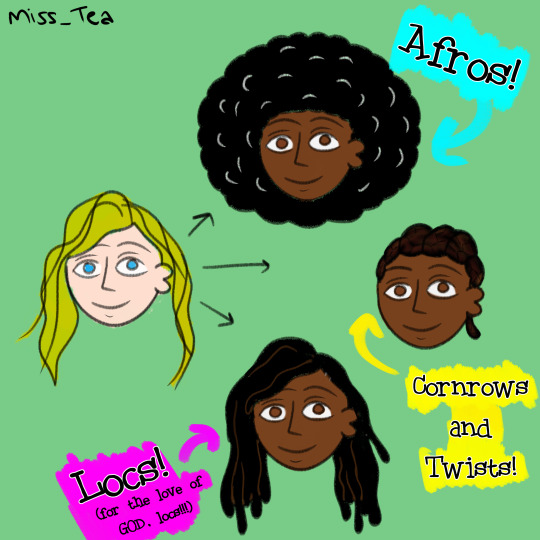
There isn't nearly enough time in the world, let alone in this little scribble and blurb, for me to describe the IMPORTANCE of Black hair in Black character design. There are so many ways to do curls, afros, braids, twists, locs, SO MANY HAIRSTYLES!! Get used to searching in the 3C-4C hair textures!!!! I plan on doing an entire lesson or two on hair alone, but suffice it to say, Hair Texture is thee BIGGEST giveaway that you 'painted a white person Black'- from cartoon styles to realistic! It reveals itself in your writing as well- just based on how your character takes care of their hair, how your describe the texture, how other people might perceive it... it lets me know just how much research was done. Because we can have straight hair! But again, that's a conversation for a whole 'nother lesson so- come back later 👀?
Lips?

I love our lips, I really do. There's a long history of shaming Black women in particular for the way our lips look. So when I see them done in all their glory, it makes me very happy. Two-toned lips vary in shade and intensity, so make sure you're using references if you want to be 'realistic', but it doesn't have to be that hard. Even a little subtle shift like this in the design/story description lets me know that a creator was thinking about me.
Nose?

One thing I've noticed ever since I starting drawing is that... people in a lot of mangas/manhwas barely have noses! I admit, out of all the features on the face, the nose isn't the most important. I think they should be, especially when you want to emphasize that your characters look different! People have different types of noses! I especially want to gear this towards those with a goal of drawing realistic portraits and the like- there, the nose is ANOTHER dead giveaway. There are Black people with aquiline and straight noses- we aren't a monolith- but is that why you drew it? Consider why you went for that nose specifically. That's part of the intent, in all this!
Now, you might be looking at me and going "Ice... this is just character design". To which my answer is: Yes! It is! It feels so basic, and yet if you ask your Black friends/peers how often they've come across this feeling of not being properly drawn/written, from fanart to professionally produced works, it's unfortunately common despite how simple of a concept it is.
I hope that you can walk away from my first lil lesson with new eyes. Remember, it's the thought that counts, but the action that delivers!
1K notes
·
View notes
Text
hot artists don't gatekeep
I've been resource gathering for YEARS so now I am going to share my dragons hoard
Floorplanner. Design and furnish a house for you to use for having a consistent background in your comic or anything! Free, you need an account, easy to use, and you can save multiple houses.
Comparing Heights. Input the heights of characters to see what the different is between them. Great for keeping consistency. Free.
Magma. Draw online with friends in real time. Great for practice or hanging out. Free, paid plan available, account preferred.
Smithsonian Open Access. Loads of free images. Free.
SketchDaily. Lots of pose references, massive library, is set on a timer so you can practice quick figure drawing. Free.
SculptGL. A sculpting tool which I am yet to master, but you should be able to make whatever 3d object you like with it. free.
Pexels. Free stock images. And the search engine is actually pretty good at pulling up what you want.
Figurosity. Great pose references, diverse body types, lots of "how to draw" videos directly on the site, the models are 3d and you can rotate the angle, but you can't make custom poses or edit body proportions. Free, account option, paid plans available.
Line of Action. More drawing references, this one also has a focus on expressions, hands/feet, animals, landscapes. Free.
Animal Photo. You pose a 3d skull model and select an animal species, and they give you a bunch of photo references for that animal at that angle. Super handy. Free.
Height Weight Chart. You ever see an OC listed as having a certain weight but then they look Wildly different than the number suggests? Well here's a site to avoid that! It shows real people at different weights and heights to give you a better idea of what these abstract numbers all look like. Free to use.
#ty for the resources#ref#reference#ugh on un u related not i hare the general notion of gatekeepign and how people online view it#just cus someone who is good at something doesnt post a hour long tutorial or 2000 character long explanation of their process#or give u step by step doesnt mean theyre gatekeeping#theyre just friggin existing online snd not serving your every whim
185K notes
·
View notes
Note
You draw anatomy and faces so well, besides just doing studies was there any sources you found really helpful?
Thank you so much! I appreciate you saying that.
Studies and reference will always be helpful of course, and just drawing drawing drawing. But in terms of specific sources for getting better at them, hmm...
A site that I still go back to now and again when I'm feeling rusty is hitokaku, which is an old japanese site that shows you how to draw different parts of the body. Definitely recommend exploring that.
Manga Materials goes into some nitty gritty of anatomy in a really in depth way that can be overwhelming if you're just getting started but is really fascinating to look at. I follow them on patreon, but I think they might have notes available for free and stuff on their twitter or other socials.
Character Design References has pinterest boards just full full full of materials to look at. Less specifically anatomy practice, but there's some anatomy materials in there you can take a look at, but also just huge databases of character sheets and things too. I get lost in this place.
Anatomy360 is a great reference, they even have some free materials that I have used for muscle reference dozens of times
I also look thru adorkastock sometimes for poses or just plain old practice.
Also if you can get your hands on any of the Morpho anatomy books, I would recommend those in a heartbeat. I have like 5 of them. Their subjects range from general anatomy, simplifying forms, exaggerated muscles, how to draw fat folds--really great stuff, mostly made up of drawings. I have referred to these books *so* many times.
Anyway...apart from that, I look at a lot of images of athletes or bodybuilders (looking at specific sports gets you different body types, so it's fun to explore), I practice faces by having a sketchbook and trying to draw people in videos i'm watching (used to be at cafes but I don't do that as much w/ the pandemic and all that). Helps you capture shapes and likenesses better if you're trying to do it fast and symbolically, you learn what details make up a person's "look," it's a lot of fun.
This is what i can think of off the top of my head. Mostly I just draw a lot and practice and do my best ;~;
140 notes
·
View notes
Note
this might be weird to ask, but how do I critically look at another person's writing and implement what I like in their writing in my own writing? I've been having trouble improving in my writing, and frankly Im not sure how to go about doing that, even. It's easy to see what I like about another person's writing, but hard to pinpoint exactly why...
THIS IS NOT WEIRD TO ASK. It is, in fact, the most important question EVER.
How to Read Like a Writer
Re-read. If you get halfway into a chapter and think, Wow this chapter is super creepy–I wonder how they did that. Or get to the end of a book and think, I feel the poignancy of the fragility of human life in an inherently volatile economic system–I wonder how the writer made me feel that way… Go back and re-read that shit.
Read slowly. When you read like a reader, you read pretty fast. When you go in for your second, or third, or fourth re-read of a passage, chapter, or book that you want to know more about, read it slowly. Really. Slowly.
Read for technique, not content. Readers read for content (”In this paragraph, Damien gave Harold a classified envelope.”). Writers read for technique. (”In this paragraph, the writer made me feel curious about the contents of the envelope by giving sensory details about its appearance and weight.”)
Ask the right questions. They usually start with HOW: How did the writer make me feel? How did they accomplish that?
Read small. Did a chapter make you feel sad? Find out WHERE EXACTLY. What paragraph, sentence, or WORD did it for you? Was it a physical detail? A line of dialogue? A well-placed piece of punctuation? Stories are made of words and sentences. Narrow it down.
Practice. Reading like a writer is a skill that takes time to develop. Over time, you’ll get better at it!
How about y’all? Anything to add to this list? I made it off the top of my head so I’m sure I’m forgetting something. What have been your experiences with learning to read like a writer?
Hope this helps!
//////////////
The Literary Architect is a writing advice blog run by me, Bucket Siler. For more writing help, check out my Free Resource Library or get The Complete Guide to Self-Editing for Fiction Writers. xoxo
19K notes
·
View notes
Text
How to write the cold
The way we feel cold is universal, but the way we contextualise it is not. Cold has a variety of connotations for readers, so it's important to decide how to use it, and what mood you want to convey in your scene.
While cold is often associated with negative aspects in writing, if there's anything the winter season teaches us, is that it can be a positive thing as well. Rather than just using the word cold, in your next writing project, try to contextualise it. Describe the weather, the light on the snow, the comfort of warmth after an icy swim, or the fear and loneliness of the dark on a cold night.
Here are our quick tips on how to write the cold:
In nature
Clean mountain air
Glittering ice crystals
Unique wildlife, like snow hares or polar bears
Snow muffled sounds
Steam rising from hot springs
Icy water in rivers and lakes
Overcast and rainy
Bright sun on fresh snow
Icebergs, glaciers, and ice floes
Storms and blizzards
Branches moving and creaking
Frozen ponds
Morning frost on grass
Snowdrops pushing through snowdrifts
Crisp and clear night skies
Wolves howling in the dark
Bare branches scraping against windows
Eerie shadows
Foods and objects
The scent of cinnamon and nutmeg
Heavy winter coats and scarves
Rich, hot meals with lots of gravy
Tea or coffee left out too long
Ice-cream, sorbets, or ice-lollies
Metal that is cold to the touch (like pots and pans or door handles)
Cold beverages straight out of the fridge
An icy bath
Freezer trucks or walk-in refrigerators
Dry ice
Crisp, fresh sheets on cold nights
Ice sculptures
A tap with a drip that freezes in place
Frozen celebratory drinks (like daiquiris)
A single cube of ice floating in a whisky glass
A cold pack for an injury
Character moods
Isolated
Lonely
Aloof
Sad
Comfortable
Snuggly
Focused
Panicked
Indifferent
A lack of affection
Calm and calculated
Disengaged
Serene
Depressed
Awestruck
Anxious
Reverent
Melancholy
Nostalgic
Impatient
Frustrated
Reflective
Character body language
Hunched shoulders
Crossed arms
Shivering
Snuggling into something warm
Rub hands together for warmth
Tight or strained expression
Biting dry lips
Furrowing brow
Glaring against brightness
Tense and rigid stance
Stand close to others
Slow, deliberate steps
Move quickly to somewhere warm
Sitting relaxed in a warm space
Actions and events
Start a fire or build a shelter
Winter hikes
Outdoor activities like skating, skiing, or sledding
Traffic jams or snowed in cars
Frozen lakes cracking underfoot
Dodging icicles falling from rooftops
Going ice-fishing
Long sea voyages
Frostbite
Suffering from a cold, the flu, or pneumonia
Brainfreeze
Snuggling under a warm duvet
Sipping from a steaming hot drink for comfort
Cold-water swimming
Walking to work in the rain
Christmas in the Northern Hemisphere
Chrismas in July in the Southern Hemisphere
Reading a good book by the fire while it snows outside
Positive aspects
While cold is often associated with negative emotions, using it as a juxtaposition can often help to accentuate the positive feelings you want to convey.
If it's cold outside, a character enjoying a hot chocolate under their duvet will give a much more positive impression than if they were simply staying in bed.
The beauty of the natural world in winter, like snow, ice, and winter foliage can also be used to create a scene of happiness and wonder.
Negative aspects
Cold is often used to describe characters who are emotionally detached, calculating, or generally unfeeling. It's become an easy way to clue your readers in to how they're meant to feel about your character.
There are also more creative ways to use the cold, however, like describing the disappointment of forgetting about a hot drink you put down somewhere and only remembering when it's already gone cold, or the feeling of shock after you first step out of a warm shower.
Helpful synonyms
chilly
frigid
icy
wintry
frosty
cool
nippy
freezing
glacial
brisk
chilled
cool
polar
bitter
snowy
raw
refrigerated
arctic
rimy
draughty
1K notes
·
View notes
Text

Rainbow mo
83K notes
·
View notes
Note
this might be weird to ask, but how do I critically look at another person's writing and implement what I like in their writing in my own writing? I've been having trouble improving in my writing, and frankly Im not sure how to go about doing that, even. It's easy to see what I like about another person's writing, but hard to pinpoint exactly why...
THIS IS NOT WEIRD TO ASK. It is, in fact, the most important question EVER.
How to Read Like a Writer
Re-read. If you get halfway into a chapter and think, Wow this chapter is super creepy–I wonder how they did that. Or get to the end of a book and think, I feel the poignancy of the fragility of human life in an inherently volatile economic system–I wonder how the writer made me feel that way… Go back and re-read that shit.
Read slowly. When you read like a reader, you read pretty fast. When you go in for your second, or third, or fourth re-read of a passage, chapter, or book that you want to know more about, read it slowly. Really. Slowly.
Read for technique, not content. Readers read for content (”In this paragraph, Damien gave Harold a classified envelope.”). Writers read for technique. (”In this paragraph, the writer made me feel curious about the contents of the envelope by giving sensory details about its appearance and weight.”)
Ask the right questions. They usually start with HOW: How did the writer make me feel? How did they accomplish that?
Read small. Did a chapter make you feel sad? Find out WHERE EXACTLY. What paragraph, sentence, or WORD did it for you? Was it a physical detail? A line of dialogue? A well-placed piece of punctuation? Stories are made of words and sentences. Narrow it down.
Practice. Reading like a writer is a skill that takes time to develop. Over time, you’ll get better at it!
How about y’all? Anything to add to this list? I made it off the top of my head so I’m sure I’m forgetting something. What have been your experiences with learning to read like a writer?
Hope this helps!
//////////////
The Literary Architect is a writing advice blog run by me, Bucket Siler. For more writing help, check out my Free Resource Library or get The Complete Guide to Self-Editing for Fiction Writers. xoxo
19K notes
·
View notes
Text

Immortal she, return to me.
Although immortality becomes her, I like to think Lady D misses her human life. Just a thought.
625 notes
·
View notes
Text

Quite licherallly beside myself blushing and kicking my feet and twirling my hair at this portrait i just finished of Opal, my dnd character. i just love her sm goiz :3 and i'm so proud of myself for this one.
49 notes
·
View notes
Text
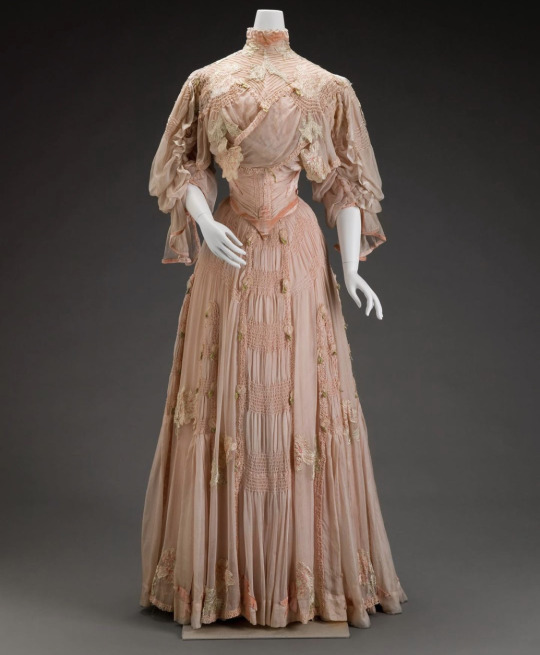

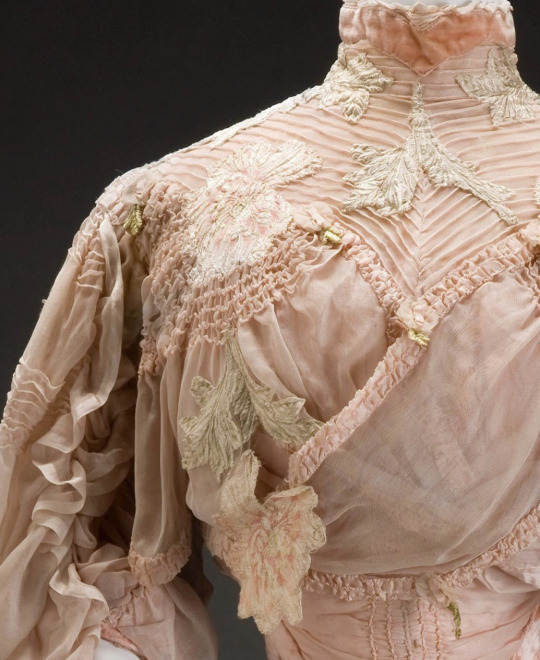

Day dress
c. 1906
Girolamo Giuseffi, Newfields
2K notes
·
View notes
Text
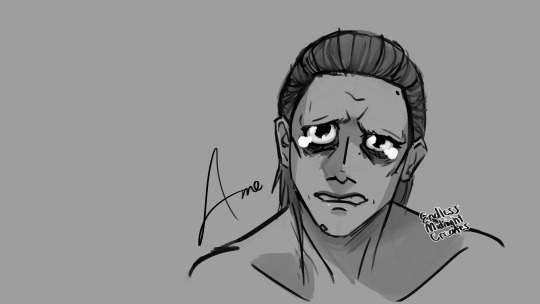


I've been wanting to draw my dnd squad but I've been too scared so I just sucked it up one day and drawed em with low stakes cus I love them too much to never draw them ❤️❤️❤️❤️
Anne belongs to @artbytesslyn, Ferrus belongs to @siobhanchiffon and Sly belongs to @Annadeef
#my art#dnd#anne#ferrus#sly#i love them your honor#literally giggling like a lil girl kicking my feet and twirling my hair while i was drawing these
16 notes
·
View notes
Text

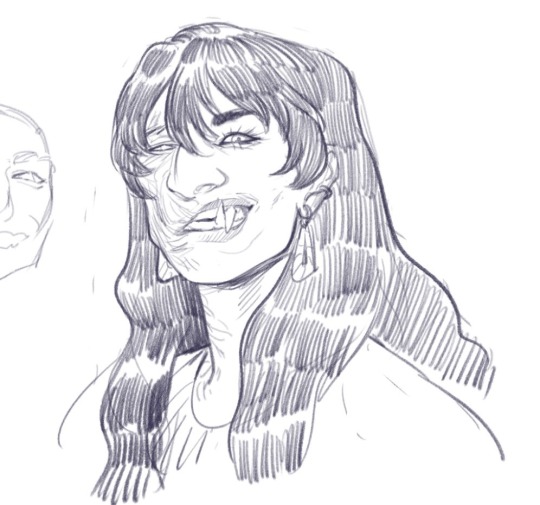
just a coupla smiley werewolves 🐺
843 notes
·
View notes